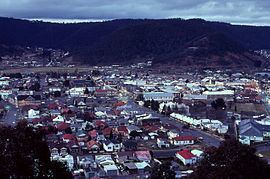Population 13,035 (2015) Postcode(s) 2790 Postal code 2790 | Established 1870s Elevation 950 m Local time Friday 3:26 PM | |
 | ||
Weather 17°C, Wind E at 18 km/h, 78% Humidity Points of interest Zig zag, Lithgow Small Arms Factory, Blast Furnace Park, Eskbank House, Queen Elizabeth Park | ||
Lithgow is a city in the Central Tablelands of New South Wales, Australia and is the administrative centre of the City of Lithgow local government area. It is located in a mountain valley named Lithgow's Valley by John Oxley in honour of William Lithgow, the first Auditor-General of New South Wales.
Contents
- Map of Lithgow NSW 2790 Australia
- Location
- History
- Climate
- Iron and steel industry
- Tourist attractions
- Media
- Notable residents
- References
Map of Lithgow NSW 2790, Australia
Lithgow is on the Great Western Highway, about 150 km (93 mi) or two hours drive west of Sydney, or via the old mountain route, Bells Line of Road, from Windsor. Geographically, it is situated on the far western side of the Sydney basin. At June 2015 Lithgow had an estimated urban population of 13,035.
Lithgow is surrounded by a varied landscape which includes national parks, one of which, the Blue Mountains National Park, is a World Heritage Area. The Wollemi National Park is home to the Jurassic-age tree the Wollemi Pine, which was found growing in a remote canyon in the park.
Location
The city sits on the western edge of the sandstone country of the Blue Mountains and is usually considered the first true country town west of Sydney. Immediate surrounding areas include the old mining hamlet of Vale of Clywydd and Oakey Park, a famous iron and steel village, of which fiery night scenes have been depicted in many paintings, as well as large areas of bush and state forest. The next city to the West is Bathurst, 60 km (37 mi) away.
Lithgow is in the NSW State electorate of Bathurst, while federally it is part of electorate of Calare. Lithgow benefits from being the western terminus for the electric section of the Main Western railway line from Sydney, and of NSW TrainLink's Blue Mountains Line electric services. Lithgow is home to the iconic zig-zag railway.
History
The mountainous terrain of the Blue Mountains and the expense of building long tunnels required the construction of The Great Zig Zag railway between 1866 and 1869. The line was opened as far as Bowenfels, just to the west, in 1869, but Lithgow station was not opened until 1877. Although it was superseded in 1910 by more modern engineering methods, including ten tunnels, parts of the Zig Zag have been developed into a popular tourist attraction. Following a period of industrialisation in the late 1860s and 1870s, the town of Lithgow boomed during the 1880s, and it was incorporated as a borough in 1889.
The town is the centre of a coal mining district and there are two coal-powered power stations nearby. It is the site of Australia's first commercially viable steel mill, the ruins of which are open for inspection at "Blast Furnace Park". Due to the abundance of coal and relative proximity to Sydney, in the areas surrounding Lithgow are two of the largest power stations in NSW, the Mount Piper and Wallerawang power stations. Both are operated by Energy Australia NSW. The (now demolished) Lithgow Power Station was in use from 1928 to 1964.
Lithgow has many heritage sites. The following are listed on the Register of the National Estate:
Lithgow was also the location of an alleged assassination attempt on the life of Queen Elizabeth II in 1970.
Climate
Lithgow features a subtropical highland climate (Köppen climate classification Cwb) with warm summers, cool to cold winters and generally steady precipitation year-round. Despite its location on highlands, Lithgow manages to have 90.3 clear days annually. Lithgow is one of the few Australian cities to see snow. One major event was the late season snowfall in October 2014, where 20 centimetres of snow fell.
Iron and steel industry
In 1848, iron smelting began in Mittagong, Australia. It proved unprofitable for the remainder of the 19th century. This situation remained until the early 20th century when no iron ore was being smelted. The only iron being cast was by William Sandford in Lithgow. His works were bought by G. & C. Hoskins in 1907, who had previously been making iron pipes in Sydney. The Lithgow works acquired a reputation for industrial disputes.
Tourist attractions
Lithgow is adjacent to a number of national parks and other attractions. Places to visit include the Zig Zag Railway, Glow Worm Tunnel, Newnes in the Wolgan Valley and Glen Davis in the Capertee Valley, the second largest canyon in the world.
Other attractions include the Hartley Historic Site, Small Arms Factory Museum, State Mine Heritage Park and the Eskbank House Museum. Lithgow is also close to Jenolan Caves, which are a World Heritage Area and lie to the south of Lithgow.
The most popular tourist attraction in Lithgow is Ironfest, an annual cultural heritage event that attracts over 10,000 visitors. Ironfest hosts the annual St George's Day Jousting Tournament which involves contestants from all around the world. The festival also features a colonial battle re-enactment, called the 'Battle of Lithgow' which involves over 120 participants, kitted out in fully authentic 19th century apparel, and involving cavalry, infantry and artillery. As well as these two historical re-enactment events Ironfest includes historical & auto displays, blacksmith demonstrations, art exhibitions, workshops and demonstrations, as well as live music and performances.
The Lithgow Greyhound Racing Club is also a popular tourist attraction with the Lithgow Workers Club sponsoring the Lithgow Golden Muzzle every summer.
Media
Electronic media in Lithgow is represented by commercial radio stations 2LT-AM and 107.9 MOVE FM, public broadcasters ABC and SBS, and commercial networks Prime7, WIN and Southern Cross Ten 7TWO, 7mate, GEM, GO!, One HD and Eleven.
